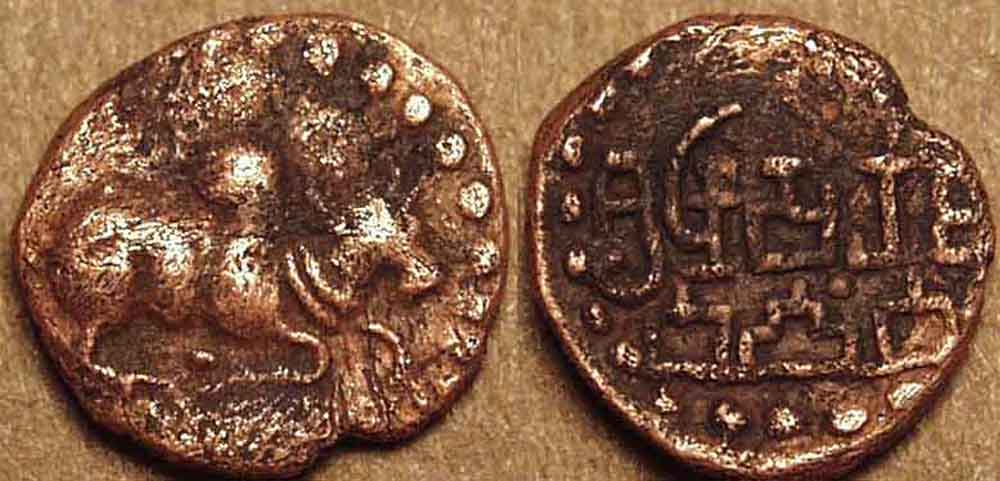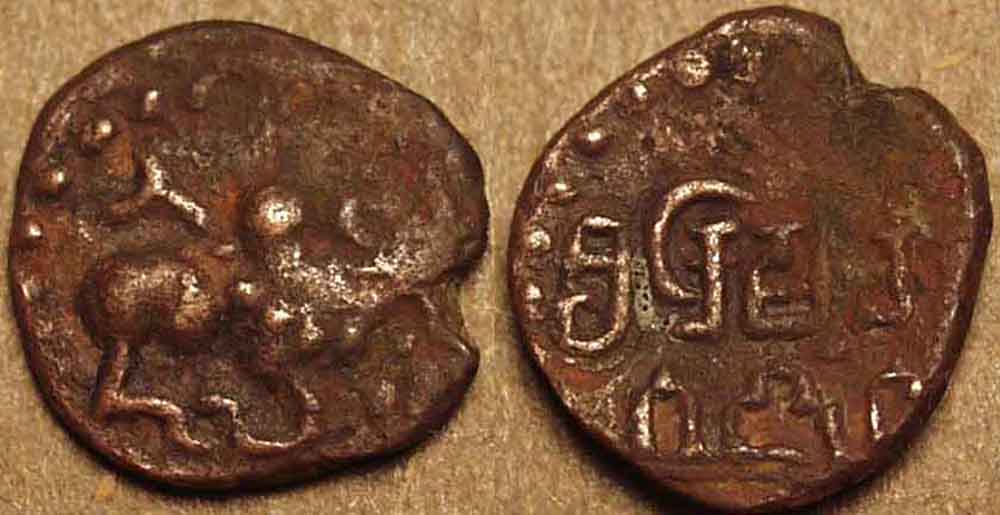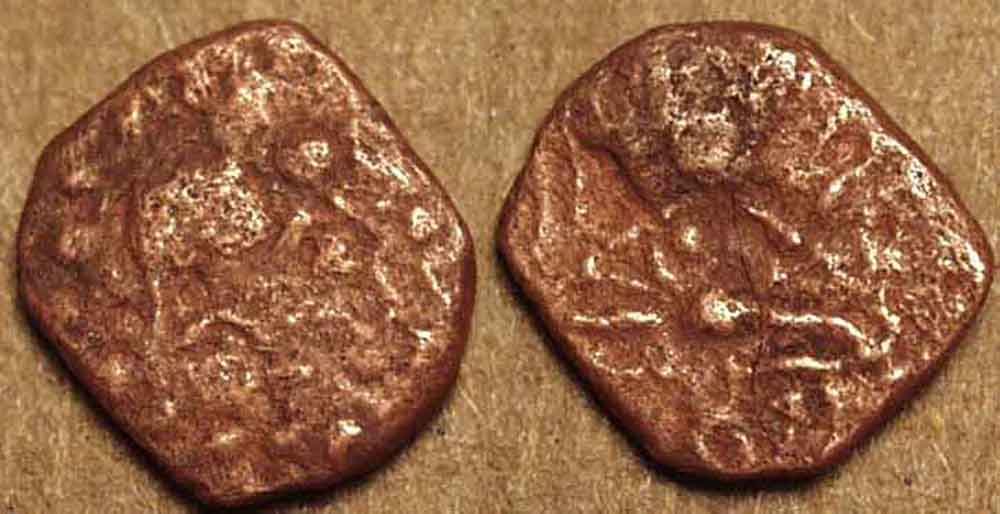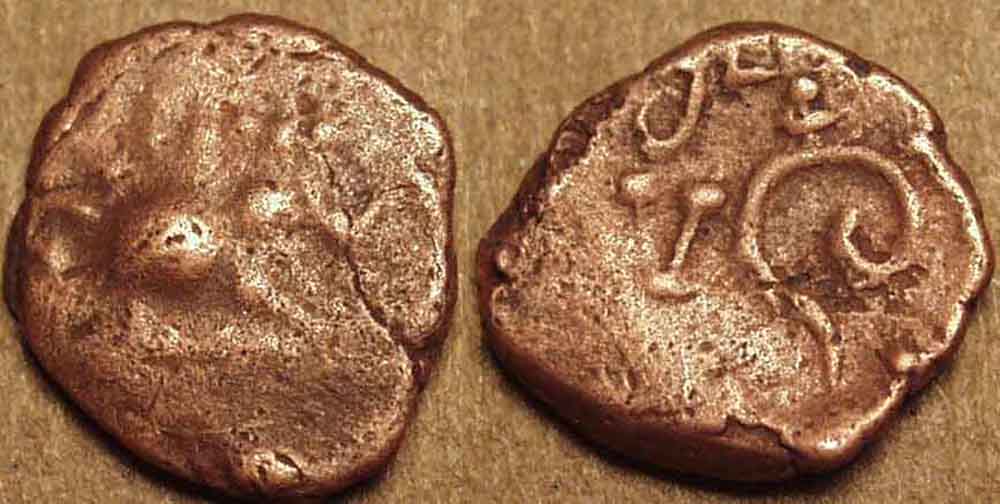
|
The origins of the Kalachuris are obscure; they may be descended from the Arjunaya tribe of northwest India. In Chalukya inscriptions, they are referred to as Haihayas and
in their own inscriptions they call themselves the Katachchuris. The early Kalachuris seemed to emerge during the decline of the Traikutakas, and initially were feudatories of the
Chalukyas. They grew to rule a large kingdom, including Malwa, southern Rajasthan and northern Maharashtra. Whether their capital was indeed Mahismati is not known for certain.
Mahismati had been the capital of Chedi, and di lie within the Kalachuri dominions, so it may well have served as their capital also. Krishnaraja is the first (and so far only, although
see below) king known to have issued coins. Copper plate grants of Krishnaraja's son Sankaragana and of his grandson
Buddharaja are known, with dates ranging from c. 596 CE (Sankaragana) to 611 CE (Buddharaja). Thus Krishnaraja must have ruled c. 550-575.
Apart from the fact that the family had several offshoots that ruled in various places in Medieval times (Tripuri, Ratnapur, and Kalyani), the early Kalachuris can lay claim to an
important position in the history of Indian art, as the builders of the famous cave temple at Elephanta Island in the Mumbai harbor and several cave temples, including the famous
cave 21 (the Rameshwar cave) in the Ellora complex. Both of these sites are World Heritage Sites. Coins of Krishnaraja were found at both sites and it is possible that the rock cut
cave temples are commemorated on his copper coinage seen below.
|
 |
Krishnaraja (c. 550-575) |

|
Krishnaraja silver rupaka or drachm
King's head right /
Bull Nandi seated right on a platform, Brahmi legend around (at 12 o'clock):
parama maheswara mata pitri padanudhyata sri krishna
Weight: 2.19 gm, Diameter: 12 mm., Die axis: 7 o'clock
Ref: MAC 5093, MNI 285, Mangalam 1
|
 |
The reverse legend is missing the last two letters of the normal legend: raja, which would complete the king's name.
The silver coins of Krishnaraja imitate the bull reverse types of Skandagupta.
|

|
Krishnaraja silver rupaka or drachm
King's head right /
Bull Nandi seated right on a platform, Brahmi legend around (at 12:30 o'clock):
parama maheswara mata pitri padanudhyata sri krishnaraja
Weight: 2.07 gm, Diameter: 12 mm., Die axis: 2 o'clock
Ref: MAC 5093, MNI 285, Mangalam 1
|
 |
The reverse legend here appears to be complete, although the style of the coin is more idealized.
|

|
Krishnaraja copper unit
Bull Nandi seated right /
Stylized Nandi seated right on a platform, Brahmi legend around (at 11 o'clock):
sri krishnaraja parama maheswara
Weight: 0.79 gm, Diameter: 10-11 mm., Die axis: 12 o'clock
Ref: Mangalam 2
|
 |
On the copper coins, Nandi takes pride of place on the obverse. Here, there seems to be a stylized Nandi on the reverse also.
|

|
Krishnaraja copper unit
Bull Nandi seated right /
Brahmi legend: sri krishnaraja, temple complex ? below
Weight: 1.09 gm, Diameter: 11 mm., Die axis: 6 o'clock
Ref: Mangalam 3a
|
 |
It is tempting to think that the "buildings" under the legend on the reverse represent the cave temples at Elephanta or Ellora.
|

|
Krishnaraja copper unit
Bull Nandi seated right, unidentified object above /
Brahmi legend: sri krishnaraja, temple complex ? below
Weight: 1.10 gm, Diameter: 12 mm., Die axis: 9 o'clock
Ref: Mangalam 3b
|
 |
It is not clear what is the object above the bull on this coin. The form of the bull closely parallels the
Nandi in the courtyard in front of cave 22 at Ellora, with the dotted garland draped behind the hump and the legs curved
delicately below.
|

|
Krishnaraja copper unit
Bull Nandi seated right, inverted crescent above /
Within dotted field, Brahmi legend: sri krishnaraja, line below
Weight: 0.83 gm, Diameter: 13-14 mm., Die axis: 9 o'clock
Ref: Mangalam 4
|

|
Krishnaraja copper unit
Bull Nandi seated right /
Deity (Lakshmi ?) seated cross-legged facing
Weight: 0.73 gm, Diameter: 9-10 mm., Die axis: 9 o'clock
Ref: Mangalam 5
|
 |
Given that the Kalachuris were devout Saivites, it is surprising to see the figure of (presumably) Lakshmi on this coin.
|

|
Krishnaraja copper unit
Bull Nandi seated right /
Stylized conch, unread legend around
Weight: 1.28 gm, Diameter: 11-13 mm., Die axis: 10 o'clock
Ref: previously unpublished
|
 |
On this coin, previously unpublished, the Vaisnavite symbolism continues with a prominent conch, an attribute of Vishnu.
|
 |
 |
 |
Buddharaja, c. 600-625 |

|
Buddharaja ? silver fraction
Elephant walking left, ridden by mahout and king ? /
Bull Nandi seated left, Brahmi legend above: buddharajadeva ?
Weight: 0.81 gm, Diameter: 8 mm., Die axis: 10 o'clock
Ref: previously unpublished
|
 |
The attribution of this coin, previously unpublished, is highly tentative. The bull on the reverse points clearly to a Kalachuri
origin, as its form matches exactly the Nandi from Cave 22 of Ellora, mentioned earlier. The elephant on the obverse does not
seem to have any clear precedent or fore-runner. Further, although the reading is quite uncertain, it is possible to see the legend as
reading buddharajadeva. Admittedly, in his inscriptions, Buddharaja is always referred to as just Buddharaja, without the title deva at the end, so I'm not so sure this
coin is his. More information is needed before we can gain any confidence in attributing this coin. Note the possible sri below the bull, which would make the legend sri
buddhrajadeva.
|
|
|